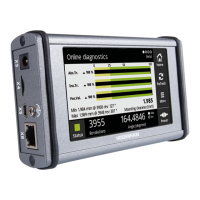7 – 50 HEIDENHAIN Technical Manual TNC 426, TNC 430
7.6 PLC Program Example
The following PLC program example was written on a PC with the PLC
programming software PLCdesign. PLCdesign is supplied together with
additional comprehensive PLC program examples in data form.
The PLC program is divided into various PLC modules, where each module
performs a specific task. This will help you to quickly recognize the program
structure and easily insert your own functions.
A file known as the documentation file describes the PLC programming
example, which can be output by PLCdesign in addition to the individual PLC
programs (see the User’s Manual for the PLCdesign PLC programming
software). In the right column of the documentation file you will find the
source code of the individual modules. This was created by the programmer
using symbolic operands and label names. The left column shows the
statements lists (STL) as they are needed by the TNC. The compiler
automatically generates these statement lists.
This juxtaposition of source code and statements list is very helpful for
understanding the program. Abbreviations were defined for the symbolic label
numbers and symbolic operands contained in the source code. These
abbreviations clearly identify the functions and thereby make the program
more understandable.
The following is an example for the definition of a general symbol name, in
which individual concepts are separated by an underline “_”:
MG_active_PWM_axis
Special cases Interface operands PLC-NC or NC-PLC, inputs and outputs, timers and
counters, and positive and negative edge markers are always globally effective
and are therefore not indicated as such.
Example NP_M2008_X_InPos
I_release_tool
TS_5_clamp_unclmp
CS_RS_Err_ReStart
Description of operand function by any text
Separator
Status: Enter if the operand type is not
specified.
Input: L = locally effective (only in the module)
G = globally effective (in all modules)
Input for operand type: M, B, W, D, K

